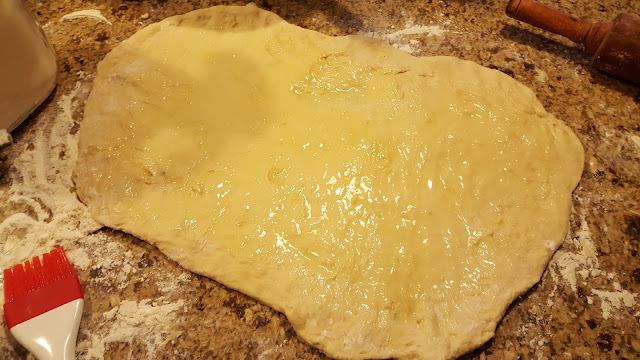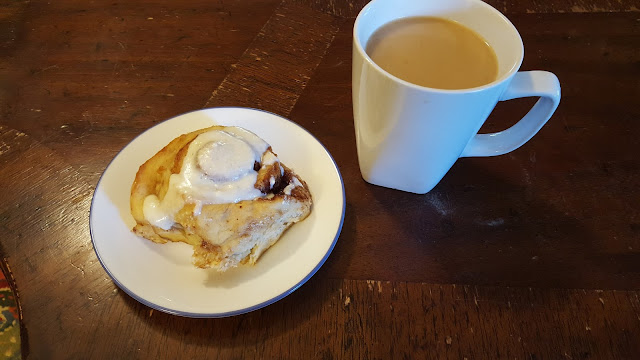Yesterday was my sister's 18th birthday, so I figured I would surprise her with homemade cinnamon rolls when she got home from school. It's not that cold here in Georgia yet, but it's never too warm to enjoy a good cinnamon roll.
Now, I don't really like to follow recipes (seems a little hypocritical right?). When I cook or bake, I typically have a recipe (or two) that is the inspiration for what I'm creating, but then I kind of just go off on my own and cook what feels and looks right. According to Vertamae Smart-Grosvenor, this is the art of vibration cooking--rely on your vibes to get your meal delicious. But enough, time for cinnamon rolls!
Warning: this recipe makes about 20 large rolls, so be prepared to loosen the belt or run some hot buns over the the neighbors (which is what we did since we're running out of room on our belts).
Start with 1 cup of butter, 1 cup of sugar, and 4 cups (one quart) of whole milk. Throw that wonderful concoction into a pot and heat on med-low. You want to melt the butter and sugar and have the whole mixture blend together, but do not let it boil!! You'll have curdled milk, and no one wants that for cinnamon rolls.
Now remove it from heat and pour into a large mixing bowl. Allow the mixture to cool down to a warm temperature (if you're as improper as I am, you'll just stick your [clean] fingers in to test).
Once it's warm, add 1 tablespoon of active yeast (equivalent to two 1/4 oz. packets from the store). The sugar is food for the yeast, and the warm temperature helps activate them more quickly.
Mix in the yeast, and allow it to proof for about five minutes. You'll be able to see bubbles froth in your butter/sugar/milk mixture. This 'proves' to you that your yeasties are working hard for you (yay for baking puns).
 |
| Notice how the mixture looks frothy here thanks to the yeast |
Once you know the yeast are flourishing, go ahead and start adding the all-purpose flour (a total of about 10 cups). Living better: substitute 3 cups with whole wheat flour instead. I add my flour two cups at a time and mix between each addition. While the soon-to-be dough looks like a batter, mix in 1 1/2 teaspoons baking powder
1 teaspoon baking soda
1 tablespoon salt
Continue mixing in flour until you start to form a dough. Try not to overwork the dough, but it should stop completely sticking to clean hands. I lost count, but I think I used about 11 cups of flour; you may use less. This is where the vibration cooking comes into play. Once it looks like this, cover the dough with a towel and let it rise for about an hour (protip: you can cheat and speed this up about 15 minutes by placing the dough near a heat source).
After an hour, uncover the dough and punch it down. Yes, that is right, give it your best gut punch and don't hold back (well, don't break the bowl either). This will help get the air bubbles out of the dough. If the dough is still very sticky, you can mix in up to a cup of flour. Take about half of the dough and roll it on a floured surface until the dough is evenly rolled in a rectangle.
Melt some butter (maybe 2/3 stick) and brush it on the dough (you'll do the same thing with the other half of the dough.
Next grab brown sugar (about two fistfulls), and spread it all over the buttered dough.
Next sprinkle cinnamon on top of the brown sugar, and rub it all together--don't be afraid to get your hands dirty, ladies and gents.
Now roll that thing up, and pinch the end to seal it. I brushed a little butter after I pinched it to keep it smooth. Repeat with the other half of the dough.
Take non-scented dental floss (about 10-12 inches) and shimmy it between the roll and the countertop about 2 inches in. Crisscross the dental floss over the top of the roll to cut the roll. Keep doing this every two inches.
You can use a very sharp knife too, but I've found that the dental floss is pretty easy (and one less dish to wash).
Place those rolls on a pan with some parchment paper. It doesn't matter if they bake together; they're easy to pull apart. Bake them for 15-17 minutes at 400 F.
 |
| Those three in the middle were parts of the ends of the roll, so I basted some butter on those babies and added some brown sugar. |
While they're baking, mix the icing
1/3 cup of soft butter
1/2 package of cream cheese
3 cups of powdered sugar
1 teaspoon vanilla
optional: 2 teaspoons of coffee for flavor
about 1/3 cup of milk (again, vibes. you just want enough for it to spread like icing)
just chuck all of the ingredients in a bowl and mix until it looks delicious.
Use your own vibrations with this recipe. You can make it 'healthier' using fat free milk, whole wheat flour, lowfat cream cheese.
Good morning to me. Hope you all enjoy. Cheers!












 +
+














